Format Pie Dialog
The Format Pie dialog helps you to format pies of a chart. It appears when you right-click a pie in a pie chart and select Format Pie from the shortcut menu, or double-click a pie of a pie chart.
The dialog contains the following tabs: General, Fill, Border, Data Label, Hint and Behaviors (the Behaviors tab is available to charts in library components only).
OK
Applies the changes and closes the dialog.
Cancel
Does not retain any changes and closes the dialog.
Apply
Applies all changes and leaves the dialog open.
Help
Displays the help document about this feature.
General
Specifies the options which are available when you format a pie chart.
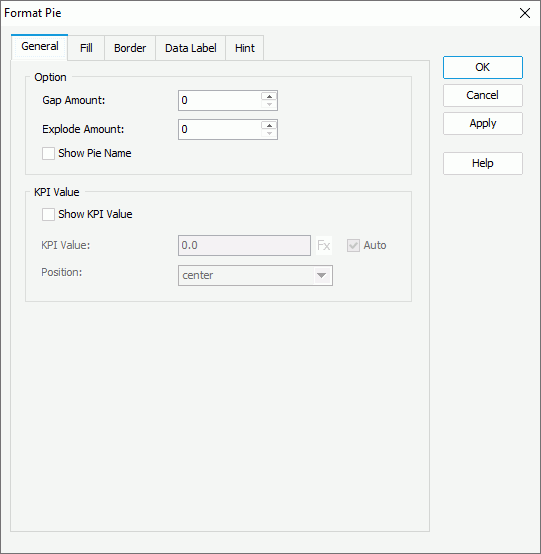
Option
- Gap Amount
Specifies the gap between two pies. - Explode Amount
Specifies the gap between every section and the central point of a pie. - Show Pie Name
Specifies whether to show the name of the pie.
KPI Value
Enabled when the chart property Swap Groups is not true.
- Show KPI Value
Specifies whether to show KPI value for each pie.- KPI Value
Specifies the KPI value to display on each pie. By default, the total value of each pie will be used as the KPI value. If you want to customize the value, clear Auto and type a value in the text box, or select and select a formula or summary from the drop-down list to use its value as the KPI value.
and select a formula or summary from the drop-down list to use its value as the KPI value. - Position
Specifies the position of the KPI value on the left, right, top, bottom of each pie or customized by dragging on any pie manually.
- KPI Value
Fill
Specifies the color, fill effect and transparency for the pie sections.
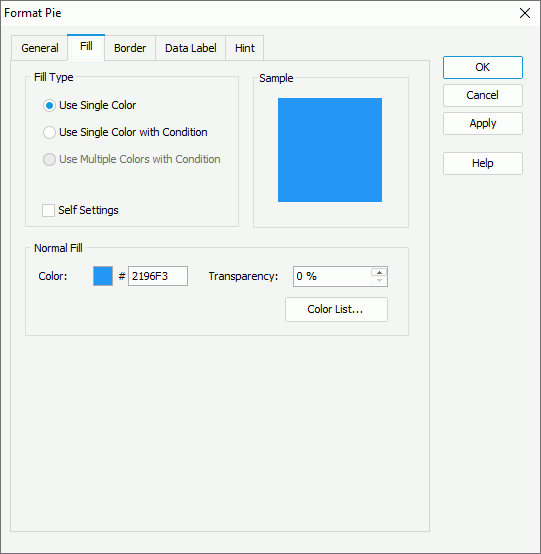
Use Single Color
If the option is selected, the pie sections will use the single color pattern.
- Self Settings
Specifies whether to edit the color pattern for the pie sections themselves. When the option is unselected, the color settings defined here will be synchronized to the Pattern List property on the chart object in the Report Inspector, which can also be applied by data markers of other subtypes if the chart is a combo chart. - Color
Specifies the color schema for the selected pie sections in the same data series. To edit the color, select the color indicator and select a color from the color palette or input the hexadecimal value (for example, 0xff0000) of a color in the text box. - Transparency
Specifies the transparency of the color schema. - Color List
Opens the Color List dialog to modify the color pattern for pie sections in the same data series respectively.
Use Single Color with Condition
If the option is selected, each pie section can have its single color pattern based on defined conditions. You can select the Advanced or Normal button to switch between the two editing modes to edit the conditions.
- Normal
- Select Field
Lists all the available fields to which the conditional fill can be applied. Select the field on which you want to define the conditions from the drop-down list. - Value
Specifies the value of the condition. Available when you select a category or series field or a field whose return value is not a number from the Select Field drop-down list. - Start Value
Specifies the start value of the condition. Available only when you select a value field or a field that returns a number from the Select Field drop-down list. - End Value
Specifies the end value of the condition. Available only when you select a value field or a field that returns a number from the Select Field drop-down list. - Color
Specifies the color that will be applied to the values which meet the condition. - Transparency
Specifies the transparency for the color of the condition. 
Adds a new condition line.
Removes the selected condition line.- Label
If the option is selected, you can modify the condition expression of the selected condition line which will be shown as the legend entry label. - Value
Specifies to display data in the condition expression as value. Available only when you select a value field or a field that returns a number from the Select Field drop-down list. - Percent
Specifies to display data in the condition expression in percent. Available only when you select a value field or a field that returns a number from the Select Field drop-down list.
- Select Field
- Advanced
- Condition
Displays the condition you have defined in the Edit Condition dialog. - Color
Specifies the color that will be applied to the values which meet the condition. - Transparency
Specifies the transparency for the color of the condition. 
Opens the Edit Conditions dialog to create or edit a condition.- Label
If the option is selected, you can modify the condition expression of the selected condition line which will be shown as the legend entry label. - Value
Specifies to display data in the condition expression as value. Available only when you select a value field or a field that returns a number from the Select Field drop-down list. - Percent
Specifies to display data in the condition expression in percent. Available only when you select a value field or a field that returns a number from the Select Field drop-down list.
- Condition
Use Multiple Colors with Condition
Not supported on pie chart.
Sample
Displays a preview sample of your selection.
Border
Specifies properties for the border of the pies.
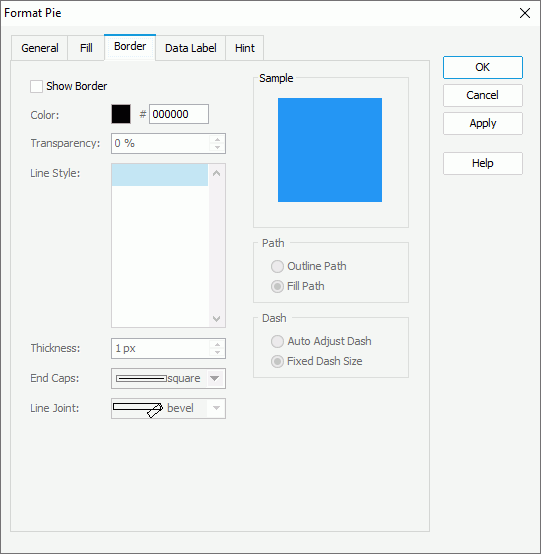
Show Border
Specifies whether to show the border of the pies. When it is selected, the other border properties in the tab will be enabled.
Color
Specifies the color for the border of the pies.
Transparency
Specifies the transparency for color of the border.
Line Style
Specifies the line style to apply to the border of the pies.
Thickness
Specifies the weight of the border.
End Caps
Specifies the ending style of the border line.
- butt
Ends unclosed sub paths and dash segments with no added decoration. - round
Ends unclosed sub paths and dash segments with a round decoration that has a radius equal to half of the width of the pen. - square
Ends unclosed sub paths and dash segments with a square projection that extends beyond the end of the segment to a distance equal to half of the line width.
Line Joint
Specifies the line joint style for the border line.
- miter
Joins path segments by extending their outside edges until they meet. - round
Joins path segments by rounding off the corner at a radius of half the line width. - bevel
Joins path segments by connecting the outer corners of their wide outlines with a straight segment.
Sample
Displays a preview sample of your selection.
Path
Specifies the fill pattern of the border line.
- Outline Path
Specifies the fill pattern of the border line to be outline path. - Fill Path
Specifies the fill pattern of the border line to be whole path.
Dash
Specifies the dash size of border line.
- Auto Adjust Dash
If selected, the dash size will be adjusted automatically. - Fixed Dash Size
If selected, the dash size will be fixed size.
Data Label
Specifies properties for data labels displayed on the pies.

Static Data Label
Specifies properties of the static data labels on the pies.
- Show Static Data Label
Specifies whether or not to show the static data labels on the pies. Only when it is selected can the following static data label related properties take effect. - Position
Specifies the position of the static data labels on the pies.- auto fit
If selected, the static data labels will be displayed automatically. - sticker
If selected, the static data labels will be displayed beside the pie sections. - slim leg
If selected, the static data labels will be displayed beside the pie sections and pointed by thin lines. - best fit
If selected, the static data labels will be displayed at the best fit position automatically. - on slices
If selected, the static data labels will be displayed on the pie sections (slices).
- auto fit
- Data Label Type
Specifies in which way to display the data values in the static data labels.- value
Shows the value for each pie section. - category name
Shows the category name for each pie section. - percent
Shows the percentage of each pie section to the total. - value and percent
Shows the value and the percentage for each pie section. - category name, value
Shows the category name and value for each pie section. - category name, percent
Shows the category name and percentage for each pie section. - category name, value, percent
Shows the category name, value and percentage for each pie section.
- value
- Auto Scale in Number
Specifies whether to automatically scale the static data labels that are of the Number data type when the label values fall into the two ranges:- When 1000 <= value < 10^15, the following quantity unit symbols of the International System of Units are used to scale the values: K (10^3), M (10^6), G (10^9), and T (10^12).
- When 0 < value < 0.001 or value >= 10^15, scientific notation is used to scale the values.
By default it is set to auto which means that the setting follows that of the chart.
- Line Color
Specifies the color of the thin lines that are used to point to the static data labels. - Suppress Label When 0
If true, the static data label whose value is 0 will not be displayed on the chart.  Show Truncated Label
Show Truncated Label
Select this option to truncate labels that would go beyond the boundaries on a pie chart paper instead of them being hidden altogether - the default behavior. Logi Report displays an ellipsis (…) from the right side of the label, along with part of the name instead of the entire name, when you select this option. The truncated labels are also affected if you select the Position option of best fit (as seen above); where the label is cut off from the left or the right depending on the position of the label.
Font
Specifies the font format of text in the data labels.
- Font list
Lists all the available font faces that can be selected to apply to the text. - Font Size
Specifies the font size of the text. - Font Color
Specifies the font color of the text. - Transparency
Specifies the color transparency of the text. - Rotation
Specifies the rotation angle of the text around its center, in degrees. The default value is 0. - Shearing
Specifies the gradient of the text.
Effects
Specifies the special effects of text in the data labels.
- Style
Specifies the font style of the text. It can be one of the following: plain, bold, italic, and bold italic. - Strikethrough
Specifies the style of the horizontal line with which the text is struck through. It can be one of the following: none, thin line, bold line, and double lines. - Underline
Specifies the style of the horizontal line under the text. It can be one of the following: none, single, single lower, bold line, bold lower, double lines, bold double, patterned line, and bold patterned. When patterned line or bold patterned is selected, a line or bold line in the pattern of the text will be drawn.Note: Web Report Studio and JDashboard do not support underlining chart text so this property will be ignored when the chart runs in Web Report Studio or is used in a dashboard.
- Superscript
Raises the text above the baseline and changes the text to a smaller font size, if a smaller size is available. - Embossed
Makes the text appear to be raised off the page in relief. - Outlined
Displays the inner and outer borders of each character. - Subscript
Lowers the text below the baseline and changes the text to a smaller font size, if a smaller size is available. - Engraved
Makes the text appear to be imprinted or pressed into the page. - Shadowed
Adds a shadow beneath and to the right of the text.
Hint
Specifies properties for the hint of the pie sections.
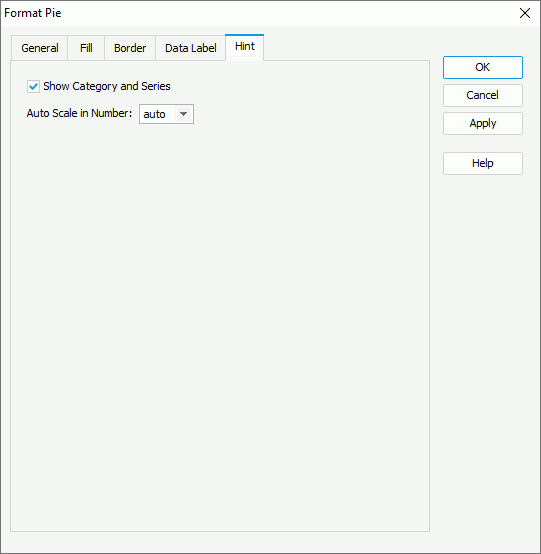
Show Category and Series
Specifies whether to include the category and series values in the hint.
Auto Scale in Number
Specifies whether to automatically scale the values displayed in the hint that are of the Number data type when the values fall into the two ranges:
- When 1000 <= value < 10^15, the following quantity unit symbols of the International System of Units are used to scale the values: K (10^3), M (10^6), G (10^9), and T (10^12).
- When 0 < value < 0.001 or value >= 10^15, scientific notation is used to scale the values.
The option "auto" means that the property setting follows that of the chart.
Behaviors
Specifies web behaviors to the pies. This tab is only available to charts in library components.
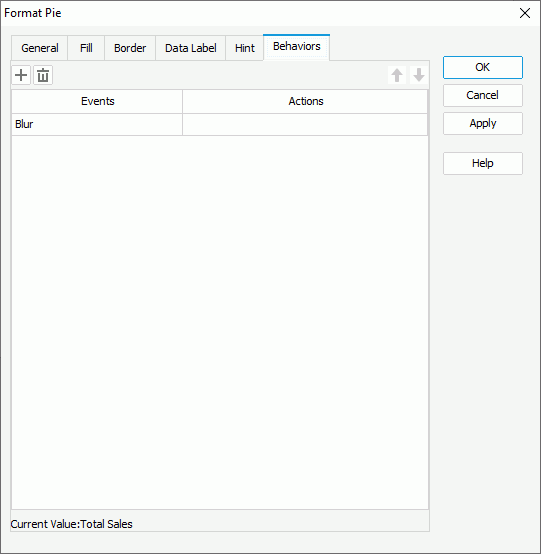

Adds a new web behavior line.

Removes the selected web behavior.

Moves the selected web behavior up a step.

Moves the selected web behavior down a step.
Events
Specifies the trigger event.
Actions
Specifies the action you want the event to trigger.

Opens the Web Action List dialog to bind a web action to the event.
 Previous Topic
Previous Topic